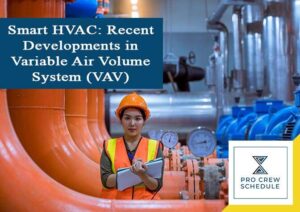HVAC systems installed in commercial buildings have been getting smarter each day. As technology is getting more advanced, the systems should adapt too. VAV or variable air volume systems are proven to provide more energy-efficient heating and cooling to modern buildings. This type of system is also used for CAV replacement purposes apart from cooling and heating buildings. VAV systems provide a much higher level of accuracy in keeping the temperature steady and consistent in numerous buildings’ zones. It is one of its outstanding advantages.
However, while a VAV system is challenging to balance that often results in air noise and drafts properly, recent advances for the system today have been resolving some of the most common issues. Let’s start exploring these advances. Read further below.
What are VAV Systems, and why they are Such a Big Deal?
There are various types of HVAC Systems, CAV and VAV. Let’s first focus on the latter. In its simplest form, Variable Air Volume (VAV) is a system that utilizes varying airflow at a consistent and stable temperature to cool and heat buildings. Unlike CAV or constant air volume systems that variate temperatures only with consistent airflow, VAV functions distinctively, the other way around.
HVAC technicians have to be careful in identifying each system’s differences since both have unique installations and HVAC maintenance requirements. Using project management software, it will be easier for any technician to list all necessary details and store them securely. The software has cloud-based storage where all files and documents can be accessed anywhere and at any chosen time. In the state of New York, a report from Globe Newswire shows the market for project management software is expected to register a CAG of 10.67% from the start of 2020 until 2025.
A VAV system conserves energy, controls humidity, and has become a vital part of any commercial buildings. There are tons of advantages that this particular system offers. That is why the Variable Air Volume system is among the preferable ventilation systems installed in commercial buildings.
Below are the advantages of installing VAV systems:
- Reduced compressor wear
- Precise temperature control
- Lower energy consumption
- Less noise and more control
- Additional passive dehumidification
Therefore, A VAV system is proven to be more efficient in comparison to other systems due to many advantages. And it also allows all parts, the chillers, and boilers to run at lower loads. The VAV box has a damper that will enable the AHU fan to keep running at a slower speed when closed.
The Role of VAV box in HVAC systems
The VAV box is one of the most vital components of the HVAC system. As the term implies, it explicitly controls the air volume and varies it. As HVAC technicians already know that most heating and cooling systems are working through the correct duct channels. It is where the air is delivered in various sectors of the commercial building. The intensity of the air cooling and heating is being maintained right from the control area. For the volume of air, it is typically managed and controlled through the VAV systems that are installed at the openings of each duct.
Moreover, below are what VAV boxes do within the system:
- Control the air’s volume amount according to the needs of a specific area.
- Monitor the temperature of any room since the system contains controllers and sensors.
- Maintaining the constant ideal temperature.
- Let the temperature begins exceeding beyond the ideal level.
No HVAC systems are perfect. However, because of VAV system’s flexibility, it comes relatively close to perfect. Today, most of the installed VAV systems can be refurbished to meet the client’s demands and expectations. For as long as the primary system is in good and reasonable condition, any specific enhancements can be made. Upgrades can be made in the following areas:
- Chillers, pumps and boiler controls can result in overall efficiency.
- Pressure-dependent VAV system converted into independent VAV system for improved feedback control.
Note: The controllers for this system are fully programmable and complex for any application-specific functions. They also include trending and integrated alarming to make for commanding edge devices that can be overall controlled via BAS systems.
Apparently, modern constructions today focus more on two zones of space – perimeter and core. The perimeter shares any wall with the outside, while the core is entirely closed. The first rooms require both cooling and heating, while the core rooms usually require heat only. Complex and technical details such as this should be documented. HVAC contractors can rely on construction project management software to type down and secure all-important project details.
Three Most Outstanding Advances in VAV Systems Today
Previous VAV systems are generally designed to vary the cfm (cubic feet per minute) fan output based upon the zone’s total cumulative needs. Also, fans were sized to accommodate the maximum probable load, regularly leading to diverse static pressure in the primary duct. The outputs are controlled by sensors that often be adjusted.
In recent years, VAV systems are proven to provide more advantages in any commercial buildings, particularly in improving indoor air quality. But then again, air and drafts noises are often the common issues that occur in the systems. Good thing that there are advances made for variable air volume systems. See below.
1. Digital Controls
By having to program heating and cooling systems area by area, anyone can be sure of IAQ (indoor-air-quality) while delivering higher possible efficiency and comfort levels from zone to zone. Digital controls can provide a consistent stream of data to the CPU and can manage complex functions. In turn, the CPU can generate energy usage reports, remotely change the parameters, and analyze system performance for tighter control.
2. VAV Terminal Units
A VAV terminal unit is usually a small box located in the air duct right at every outlet’s zone. It receives air right from the central unit and utilizes a butterfly damper to control airflow in the automatic air control system’s direction. These VAV terminal units are pressure-independent and can fully control both the maximum and minimum cfm to balance airflow in every terminal properly.
3. Improved Motors and Fans
Improved direct-drive fans and motors deliver even more benefits for VAV systems, including lesser maintenance, increased efficiency, greater redundancy, and smaller footprints. Eliminating pulley and belt systems lessen the noise levels. Wear and tear levels stay at an absolute minimum level by merely instituting warm-up cycles specifically for fans. Moreover, sizing up the fans using lower energy consumption is also considered.
Compare to conventional systems, and a VAV system saves as much as thirty percent in energy costs because of these advances. Early VAV systems provide cooling only with a separate heating system for perimeter rooms. But today, both of these advances and modern technology have allowed for VAV system construction to become more efficient in terms of cooling and heating management.
Why Must HVAC Technicians Consider Using Construction Scheduling Software?
If you are an HVAC contractor, chances are there that you will discover HVAC projects to be way more difficult and complicated than others. The projects would include various things to keep track of, from planning and managing to deliver the final product. Project planning and scheduling are considered as a long-drawn process. While a notebook and pen are all you need to check the progress, a software solution is more advanced as it help you create an itemized list of all deliverables and tasks.
This is where the best construction management software for builders and contractors comes to play. Pro Crew Schedule software is the best in the market this 2021. You can sign-up for a free trial and get a live demo!
Here are some of the fantastic benefits of deploying this software:
- Real-time updates – the latest tech-savvy scheduling software provides more real-time updates. It allows for better collaboration and efficiency.
- Resource and Crew management – the software uses real-time technology to deliver project overview and insights. Contractors can monitor each crew and resource allocation.
- Transparency and accountability – the ability to be held accountable for every task are one of the most crucial things. This software solution offers a central location for all participating crew. It all track every resource used, task, and costs.
- Real-time collaboration – everyone in the team communicates more efficiently using this software. When communication is consistent and so is the collaborative effort of everyone.
- Time-tracking – tracking all resources and crew members is one of the best features this software has. Everyone can track all details, and contractors can monitor labor hours.
- Establishment of strategy and efficient project management for construction– knowledge obtained from effectively deploying this software is invaluable. Project managers and contractors become much better at decision-making. The data gathered can lead to expected outcomes, thus, making an accurate strategy and making project management more effective.
- Easy to Use and Deploy – most experienced workers are oldies and have many catching up to do with all the technologies and innovations deployed onsite. But this software tool is very user-friendly and so easy to explore and navigate. There’s nothing to worry about anymore.
Key Takeaways
Over the years, VAV systems have instantly become an installation favorite. With the recent advances in the VAV system, together with the relative ease of installation, it becomes the most preferred option for modern buildings. The additional long-term energy and cost-savings associated with a VAV system play a critical role when considering ventilation options.







